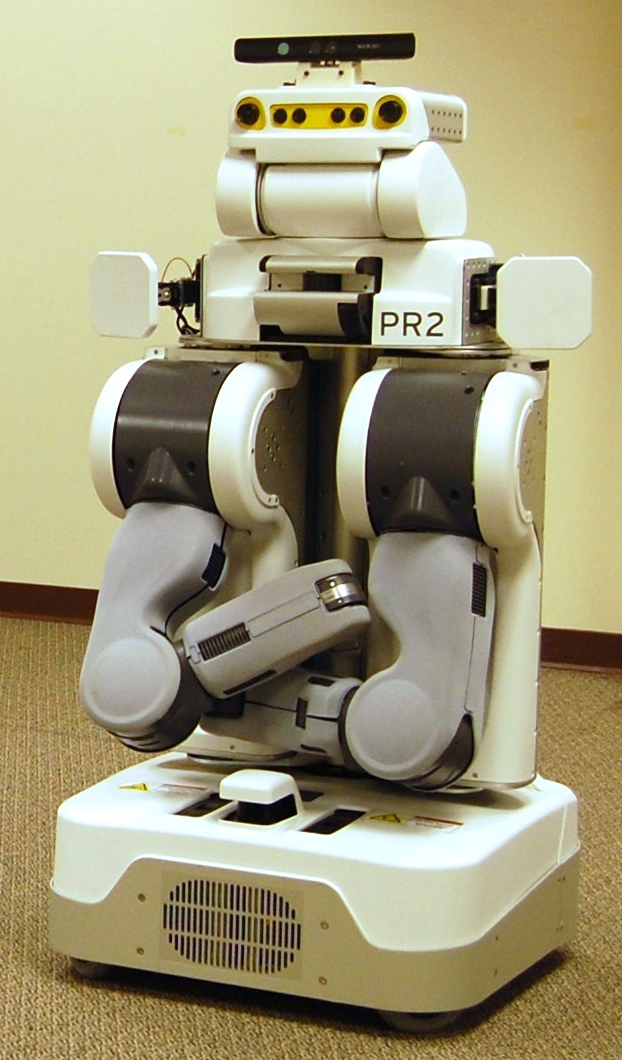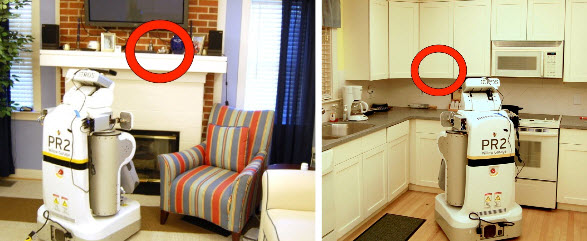New UHF RFID technology helps robots find household objects
September 24, 2014

Researchers equipped a PR2 robot with articulated, directionally sensitive antennas and a new algorithm that allows the robot to successfully find and navigate to objects (credit: Georgia Tech/Travis Deyle)
A new search algorithm that improves a robot’s ability to find and navigate to tagged objects in a room or house has been developed by Charlie Kemp, an associate professor in Georgia Tech’s Wallace H. Coulter Department of Biomedical Engineering, former Georgia Tech student Travis Deyle, and University of Washington Professor Matthew Reynolds,
The team has implemented their system in a PR2 robot, allowing it to travel through a home and correctly locate different types of tagged household objects, including a medication bottle, TV remote, phone and hair brush.
The research was presented September 14-18 in Chicago at the IEEE/RSJ International Conference on Intelligent Robots and Systems (IROS).
How to help robots find things
Mobile robots could be much more useful in homes, if they could locate people, places and objects. Today’s robots usually see the world with cameras and lasers, which have difficulty reliably recognizing things and can miss objects that are hidden in clutter.
A complementary way robots can “sense” what is around them is through the use of small ultra-high frequency radio-frequency identification (UHF RFID) tags.
Inexpensive self-adhesive tags can be stuck on objects, allowing an RFID-equipped robot to search a room for the correct tag’s signal, even when the object is hidden out of sight. Once the tag is detected, the robot knows the object it’s trying to find isn’t far away. But RFID doesn’t tell the robot where it is.
The researchers have equipped a PR2 robot with articulated, directionally sensitive antennas and a new algorithm that allows the robot to successfully find and navigate to the intended object. These antennas tend to receive stronger signals from a tag when they are closer to it and pointed more directly at it. By moving around the antennas on its shoulders and driving around the room, the PR2 can figure out the direction it should move to get a stronger signal from a tag and thus become closer to a tagged object.
In contrast to other approaches, the robot doesn’t explicitly estimate the 3D location of the target object, which significantly reduces the complexity of the algorithm.
“Instead the robot can use its mobility and our special behaviors to get close to a tag and oriented toward it,” said Deyle, who conducted the study in Kemp’s lab while earning his doctoral degree in Electrical and Computer Engineering from Georgia Tech.
Delivering medications

Two final robot configurations after performing a UHF RFID search algorithm for a tagged object on a fireplace mantle and inside a kitchen cabinet. Object locations are denoted by red circles. (Credit: Travis Deyle et al./IROS 2014)
Deyle, who currently works at Google, says the research has implications for future home robots and is particularly compelling for applications such as helping people with medicine, as RFID is able to provide precise identification information about an object or a person.
“This could allow a robot to search for, grasp and deliver the right medication to the right person at the right time,” he added. “RFID provides precise identification, so the risk of delivering the wrong medication is dramatically reduced. Creating a system that allows robots to accurately locate the correct tag is an important first step.”
Reynolds added, “While we have demonstrated this technology with a few common household objects, the RFID tags can uniquely identify billions of different objects with essentially zero false positives. This is important because many objects look alike, yet must be uniquely identified – for example, identifying the correct medication bottle that should be delivered to a specific person.”
“With a little modification of the objects in your home, a robot could quickly take inventory of your possessions and navigate to an object of your choosing,” said Kemp, a professor in Georgia Tech’s School of Biomedical Engineering. “Are you looking for something? The robot will show you where it is.”
This work was supported in part by National Science Foundation, an NSF Graduate Research Fellowship Program award and Willow Garage.
HealthcareRobotics
Abstract of IROS 2014 paper
We address the challenge of finding and navigating to an object with an attached ultra-high frequency radio-frequency identification (UHF RFID) tag. With current off-the-shelf technology, one can affix inexpensive self-adhesive UHF RFID tags to hundreds of objects, thereby enabling a robot to sense the RF signal strength it receives from each uniquely identified object. The received signal strength indicator (RSSI) associated with a tagged object varies widely and depends on many factors, including the object’s pose, material properties and surroundings. This complexity creates challenges for methods that attempt to explicitly estimate the object’s pose. We present an alternative approach that formulates finding and navigating to a tagged object as an optimization problem where the robot must find a pose of a directional antenna that maximizes the RSSI associated with the target tag. We then present three autonomous robot behaviors that together perform this optimization by combining global and local search. The first behavior uses sparse sampling of RSSI across the entire environment to move the robot to a location near the tag; the second samples RSSI over orientation to point the robot toward the tag; and the third samples RSSI from two antennas pointing in different directions to enable the robot to approach the tag. We justify our formulation using the radar equation and associated literature. We also demonstrate that it has good performance in practice via tests with a PR2 robot from Willow Garage in a house with a variety of tagged household objects.